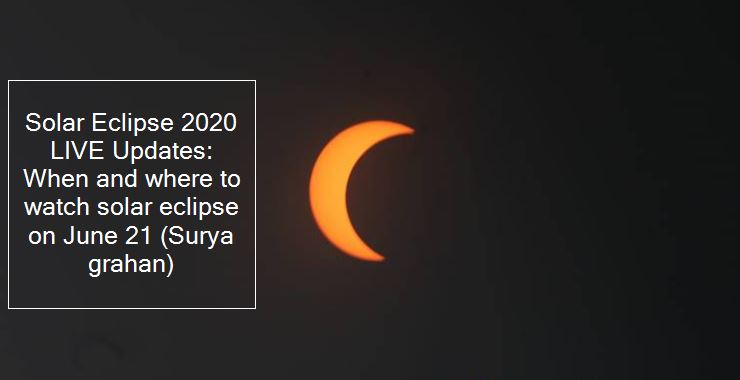Solar Eclipse 2020 LIVE Updates: When and where to watch solar eclipse on June 21 (Surya grahan)
Solar Eclipse (Surya Grahan) June 2020 Date, Timings in India Live Updates: The first solar eclipse of the year 2020 will be seen tomorrow morning in India.
Solar Eclipse (Surya Grahan) June 2020 in India Live Updates: When the Sun, the Moon, and the Earth are aligned in a straight line or an almost straight configuration, such that the Moon comes between the Sun and Earth blocking the rays of Sun from directly reaching the Earth, we witness a solar eclipse. Based on the alignment, there are three kinds of solar eclipses — total, partial, and annular — along with the addition of a rare hybrid of an annular and a total solar eclipse.
The solar eclipse of June 21 is an annular eclipse where the Moon is so far from Earth that its relative size fails to cover the Sun completely and leaves the outer rims visible, thus creating a ring of fire in the sky. The June 21 solar eclipse is the first solar eclipse of the year 2020. The second and last solar eclipse of the year will occur in December but it won’t be visible in India. The annular solar eclipse on June 21 will be the last eclipse to be seen from India until October 25, 2022.
According to Nehru Planetarium, Bhuj will be the first city in India from where the beginning of the eclipse will be visible at 9.58 am. The eclipse will end four hours later at 2.29 pm. Looking at the Sun directly can cause permanent damage to the retina so it is recommended to use special goggles, welder’s shield, or pin-hole imaging technique to see the solar eclipse.
Solar Eclipse or Surya Grahan 2020 Today in India Live Updates: The June 21 solar eclipse will start at 9:15 AM IST and will be visible until 3:04 PM IST. The maximum eclipse will take place at 12:10 IST. The eclipse will be visible from much of Asia, Africa, the Pacific, the Indian Ocean, parts of Europe and Australia.
When is the next solar eclipse?
On June 21 we will get to see the first solar eclipse of 2020. According to the Nehru Planetarium, this is also the last solar eclipse of the year that will be visible from India for the next 28 months. The next solar eclipse visible from India will take place on October 25, 2022.
[amazon box=”B07H97FRX5″ “small”]

Things you should not do during Solar Eclipse
India will witness an annual solar eclipse tomorrow, June 21. This is the first solar eclipse of the year. Some don’t you must keep in mind: Don’t look at the Sun directly, ordinary sunglasses should not be used to view the phenomenon, do not look at the reflection of the Sun in the water, and do not try to cover glass with lampblack or carbon soot and then try to view the eclipse.
How annular solar eclipse occurs
When the Moon is near its farthest point from the Earth (known as apogee), its relative size fails to completely block the Sun and leaves the outer rims visible. It creates a ring of fire in the sky. This kind of solar eclipse is called an annular solar eclipse
How solar eclipse happens
Whenever the Earth, Sun, and the Moon form a straight line, we witness either a solar eclipse or a lunar eclipse depending on the position of the three bodies relative to each other. When the Moon comes between the Earth and the Sun, it casts a shadow on the Earth blocking the rays of Sun from directly reaching the planet, thus creating a solar eclipse on Earth. Based on the alignment and the relative distance between the three celestial bodies, there are three kinds of solar eclipses — total, partial, and annular. The June 21 event will be an annular solar eclipse.
Solar Eclipse or Surya Grahan 2020 Today in India Live Updates: The first solar eclipse of this year will take place on June 21, 2020. It will be an annular solar eclipse, during which the Moon covers the Sun from the centre leaving the outer ring visible, thus creating a ring of fire in the sky. This happens when the Moon is far away from Earth that makes its relative size not big enough to cover the Sun completely. The June 21 solar eclipse will start at 9:15 AM IST and will be visible until 3:04 PM IST. The maximum eclipse will take place at 12:10 IST. The eclipse will be visible from much of Asia, Africa, the Pacific, the Indian Ocean, parts of Europe and Australia.




